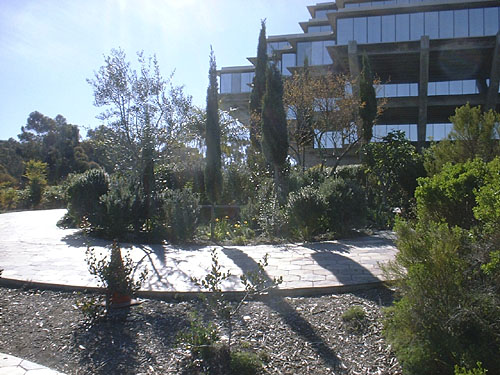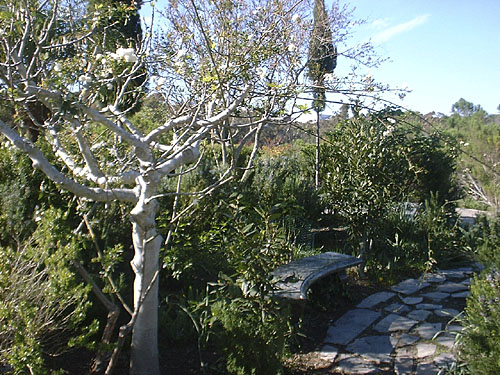I just wrote about Robert Irwin’s terrific artwork in the UCSD Stuart collection. The collection has another piece that I like, Alexis Smith’s Snake Path, from 1992.
From the collection’s page on the artist:
Smith’s work for the Stuart Collection alludes to the complex relationship between nature and culture or, in the context of the university, between knowledge and the landscape. Her Snake Path consists of a winding 560-foot-long, 10-foot-wide footpath tiled in the form of a serpent whose head ends at the terrace of the Central Library. The tail wraps around an existing concrete pathway as a snake would wrap itself around a tree limb. Along the way, the serpent’s slightly rounded body passes a monumental granite book carved with a quote from Milton’s Paradise Lost. The snake then circles around a small tropical garden representing Eden. These pointed allusions to the biblical conflict between innocence and knowledge mark an apt symbolic path to the university’s main repository of books. The concept of finding sanctuary within oneself – outside the idealistic and protected confines of the university – speaks directly to the student on the verge of entering the “real world.”
Here’s their official overview picture of the work:

And here are some snapshots from a walk there last week, first a closeup of the hexagonal slate tiles that make up the snake’s “scales”:

…and here are a couple shots of Eden, maybe not exactly “tropical,” as described, but a lush planting that contrasts to the surrounding native vegetation:


The plants in “Eden” are plants that have biblical references or those that somehow look like they’d belong in an eden. In the two pictures above you can see how the Italian cypresses have been pruned in a way that to me recalls some of the plants in the background of Leonardo’s 1470s Annunciation, now at the Uffizi Gallery in Florence:

So…you can study garden books on how to prune a plant–or you can study a painting by Leonardo da Vinci!
